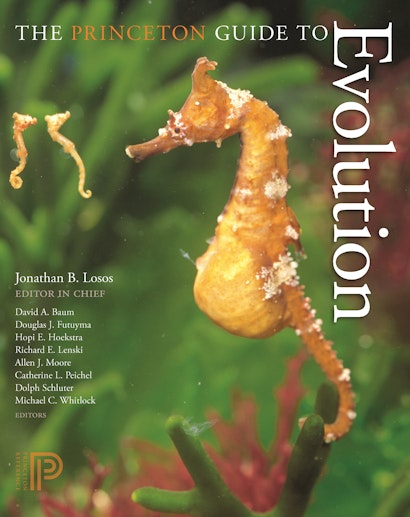The Princeton Guide to Evolution is a comprehensive, concise, and authoritative reference to the major subjects and key concepts in evolutionary biology, from genes to mass extinctions. Edited by a distinguished team of evolutionary biologists, with contributions from leading researchers, the guide contains some 100 clear, accurate, and up-to-date articles on the most important topics in seven major areas: phylogenetics and the history of life; selection and adaptation; evolutionary processes; genes, genomes, and phenotypes; speciation and macroevolution; evolution of behavior, society, and humans; and evolution and modern society. Complete with more than 100 illustrations (including eight pages in color), glossaries of key terms, suggestions for further reading on each topic, and an index, this is an essential volume for undergraduate and graduate students, scientists in related fields, and anyone else with a serious interest in evolution.
- Explains key topics in some 100 concise and authoritative articles written by a team of leading evolutionary biologists
- Contains more than 100 illustrations, including eight pages in color
- Each article includes an outline, glossary, bibliography, and cross-references
- Covers phylogenetics and the history of life; selection and adaptation; evolutionary processes; genes, genomes, and phenotypes; speciation and macroevolution; evolution of behavior, society, and humans; and evolution and modern society
Jonathan B. Losos is the Monique and Philip Lehner Professor for the Study of Latin America and professor of organismic and evolutionary biology at Harvard University.
"Biology students will find this material helpful, and those with a desire to learn more about the history of life, genes, evolutionary processes, and the like might also find this a worthwhile title to peruse. A comprehensive guide to all aspects of evolution. Great for students and teachers of the subject."—Library Journal
"This comprehensive reference covers an enormous breadth of information on the major subjects and key concepts in evolutionary biology. . . . The list of international contributors consists of leading evolutionary biologists from a variety of academic institutions."—Booklist
"The writers have worked hard (and succeeded) to make the text as easily readable to the non-specialist reader . . . losing the textbook rigor that will be required by the specialist, who wants an up to date and comprehensive reference. I would thoroughly recommend this book both for those who are struggling with epigenetics and for experts who need all the arguments for the facts about evolution easily to hand."—Brian Livingstone, Biological Journal of the Linnean Society
"This massive compendium of 107 chapters covers just about everything there is to know about evolution. . . . Overall, an excellent starting point for deeper investigation."—Choice
"Princeton University Press, together with the editors and contributors to The Princeton Guide to Evolution, deserve massive congratulations for having produced an exhaustive and fascinating guide to one of the most important of all scientific truths."—Charles H. Middleburgh, Charles Middleburgh Blog
"All in all, a good and useful book."—John Goodier, Reference Reviews
"I will make extensive use ofThe Princeton Guide to Evolution, and I recommend it to everyone who has questions (and answers) about evolution—what it is, and how it works. Congratulations to the editors and the contributors for a work that will serve a very broad readership well."—Marvalee H. Wake, Reports of the National Center for Science Education
"A fascinating tour de force through the multifaceted ideas and facts of one of the most important scientific fields."—Christoph Oberprieler , Journal of Plant Physiology
"The marvelous new tools and theoretical approaches that have so greatly deepened our understanding of evolution over the past few decades are clearly and concisely presented in this splendid new guide, which should be of use to everyone involved in the field."—Peter H. Raven, president emeritus of the Missouri Botanical Garden, St. Louis


